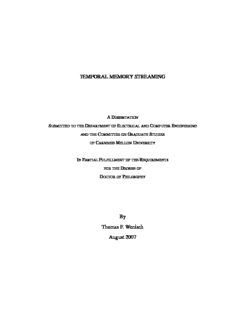Table Of ContentTEMPORAL MEMORY STREAMING
A DISSERTATION
SUBMITTED TO THE DEPARTMENT OF ELECTRICAL AND COMPUTER ENGINEERING
AND THE COMMITTEE ON GRADUATE STUDIES
OF CARNEGIE MELLON UNIVERSITY
IN PARTIAL FULFILLMENT OF THE REQUIREMENTS
FOR THE DEGREE OF
DOCTOR OF PHILOSOPHY
By
Thomas F. Wenisch
August 2007
© Copyright 2007 by Thomas F. Wenisch
All Rights Reserved
ii
Abstract
While device scaling has led to continued processor performance improvement, scaling
trends in DRAM technology have favored improving density over access latency. As a result, pro-
cessors in modern servers spend much of execution time stalled on long-latency memory accesses.
The conventional approach to latency tolerance—enlarging the on-chip cache hierarchy as transis-
tor budgets scale—is providing diminishing returns because today's multi-megabyte caches
already capture available locality. Commercial server applications present a particular challenge
for memory system design because current prefetching/streaming approaches are often ineffective
on the irregular data structures and dependent miss chains characteristic of these applications. To
further improve server performance, architects must design mechanisms that issue memory
requests earlier and with greater parallelism in the face of complex access patterns.
Despite their complexity, commercial applications nonetheless execute repetitive code
sequences, which give rise to recurring data structure traversals. As a result, memory addresses are
temporally-correlated—addresses accessed near one another in time often recur together. By
recording temporally-correlated cache miss addresses and using the recorded information to pre-
dict future misses, irregular yet repetitive miss patterns can be predicted. To exploit temporal
address correlation, we propose Temporal Memory Streaming, a memory system design paradigm
where hardware mechanisms observe repetitive miss sequences at runtime and use recorded
sequences to stream data from memory in advance of individual requests.
iii
Acknowledgements
Foremost, I wish to recognize Babak Falsafi, my thesis advisor, who has taught me to think,
write, speak, and do research. I owe him many beers for the efforts he has made to prepare me for
an academic career.
I thank Mark Hill, James Hoe, and Todd Mowry for serving on my thesis committee and for
their advice in seeking a career in academia. To Anastasia Ailamaki and Andreas Moshovos, my
thanks for their collaboration and guidance in my research.
There are many students at Carnegie Mellon University without whom I could not have
completed this work. Se-Hyun Yang and Chris Gniady taught me how to be a successful graduate
student. Without Roland Wunderlich and his work on measurement methodology, none of the
results in this thesis would be possible. Nikos Hardavellas and Jangwoo Kim invested years of
their lives in the preparation and tuning of our workloads. Mike Ferdman, Stephen Somogyi, Jared
Smolens, and Brian Gold spent countless hours locating obscure bugs in our tools. I thank all those
who endured my “Template Tomfoolery” with good humor.
I wish also to recognize my friends and teachers at the University of Rhode Island. Augus-
tus Uht set me on the path that led me to computer architecture, graduate school, and Carnegie
Mellon. John Grandin made my year abroad in Germany possible. My many friends in the Gaming
Club always challenged me to keep my mind sharp and head clear (and eyes peeled for incoming
frisbees).
I am forever indebted to my parents, Theresia and Fritz Wenisch, for their unconditional
love and support and for teaching me the importance of education; and to my siblings, Magdalena
iv
Andres and Michael Wenisch, for the inspiring example they set. I wish to thank Gerald and Janice
Neylon for their encouragement and hospitality during the many visits to Rhode Island that Shan-
non and I (and our cats) have made.
I wish to acknowledge the good people of the ISOMAC corporation for the wonderful
espresso that their machines produce; Matt Koeske for his high standards and discriminating taste
that allowed only the best beans to reach our shelves; the students of A-level who ensured my oft-
lost mug would always find its way home; and the faculty of A-level whose financial support guar-
anteed my coffee cup would remain forever bottomless.
Finally, I dedicate this thesis to my wife, Shannon Wenisch, for the patience, support, and
love she has given me all these years.
v
vi
vii .
Table of Contents
Abstract............................................................................................................................iii
Acknowledgements..........................................................................................................iv
List of Figures..................................................................................................................xi
List of Tables..................................................................................................................xv
Chapter 1 Introduction...............................................................................................1
1.1 Temporal address correlation..................................................................................3
1.2 Temporal Memory Streaming.................................................................................4
1.3 Scope of study........................................................................................................6
1.4 Contributions..........................................................................................................8
Chapter 2 Temporal Address Correlation...............................................................11
2.1 Motivating examples............................................................................................12
2.1.1 Example one: B+-tree range scans.....................................................................13
2.1.2 Example two: Solaris thread scheduler..............................................................14
2.2 Quantifying temporal address correlation............................................................15
2.2.1 A formal definition for repetitive streams..........................................................16
2.2.2 The SEQUITUR hierarchical compression algorithm........................................17
2.2.3 Methodology.......................................................................................................19
2.2.4 TMS opportunity................................................................................................22
2.2.5 Stream lookup.....................................................................................................31
2.3 Stream Characterization.......................................................................................38
2.3.1 Stream length......................................................................................................39
2.3.2 Stream reuse........................................................................................................43
viii
2.3.3 Stride patterns and miss repetition......................................................................46
2.4 Sources of repetitive streams...............................................................................48
2.4.1 Methodology.......................................................................................................49
2.4.2 Results.................................................................................................................50
2.5 Summary..............................................................................................................59
2.5.1 Projected coverage..............................................................................................59
Chapter 3 TMS-DSM................................................................................................63
3.1 Streaming in DSM...............................................................................................64
3.2 Hardware design..................................................................................................65
3.2.1 Logging misses....................................................................................................66
3.2.2 Finding & forwarding streams............................................................................68
3.2.3 The stream engine...............................................................................................70
3.3 Evaluation methodology......................................................................................74
3.4 Results..................................................................................................................77
3.4.1 Streaming effectiveness.......................................................................................77
3.4.2 End-of-stream detection......................................................................................79
3.4.3 Sensitivity to stream queues................................................................................81
3.4.4 Sensitivity to SVB size........................................................................................82
3.4.5 CMOB capacity requirements.............................................................................83
3.4.6 Bandwidth overhead............................................................................................85
3.4.7 Streaming timeliness...........................................................................................86
3.4.8 Performance impact.............................................................................................90
3.4.9 Synergy with stride prediction............................................................................91
3.5 Summary..............................................................................................................94
Chapter 4 TMS-CMP................................................................................................97
4.1 Challenges & opportunities in the CMP..............................................................98
4.1.1 Stream lookup for main memory streaming......................................................100
4.1.2 Intra-chip streaming..........................................................................................101
4.2 Main memory streaming....................................................................................102
ix .
4.2.1 Design...............................................................................................................103
4.2.2 Methodology......................................................................................................110
4.2.3 Results...............................................................................................................112
4.3 Intra-chip streaming............................................................................................125
4.3.1 Design...............................................................................................................125
4.3.2 Results..............................................................................................................128
4.4 Summary.............................................................................................................134
Chapter 5 Related Work.........................................................................................137
Chapter 6 Conclusions............................................................................................143
6.1 Future work........................................................................................................145
Bibliography.................................................................................................................147
x
Description:DOCTOR OF PHILOSOPHY. By. Thomas F. Wenisch To Anastasia Ailamaki and Andreas Moshovos, my thanks for their collaboration and guidance

